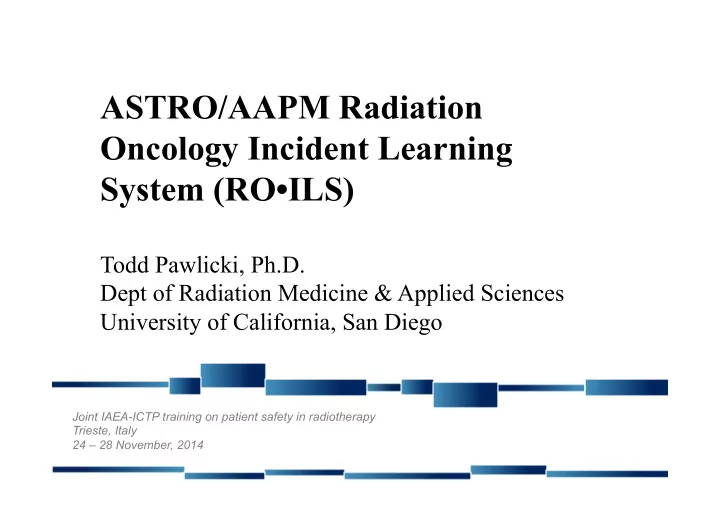

ASTRO/AAPM Radiation Oncology Incident Learning System (RO•ILS) Todd Pawlicki, Ph.D. Dept of Radiation Medicine & Applied Sciences University of California, San Diego Joint IAEA-ICTP training on patient safety in radiotherapy Trieste, Italy 24 – 28 November, 2014
ASTRO’s 6-Point Plan 1. Create a database for RT error reporting 2. Develop a new practice accreditation program 3. Expand quality and safety education/training 4. Develop tools for patients 5. Further develop interconnectivity compliance 6. Advocate for expanded legislation
Why create a national ILS? 1 Incident: March 2005 Public knowledge: January 2010 2 Incident: March 2008 Public knowledge: September 2013
Other Benefits of an ILS • Safety improvement (data-based) • Better insight into processes – “I did not know that!” • Resource and effort allocation • Whether or not quality/safety interventions work • Positive staff experience
A National U.S. Error Database • Patient Safety and Quality Improvement Act – Signed into law July 29, 2005 – Share information about patient safety events without liability – Allowed for the creation of Patient Safety Organizations (PSOs)
Patient Safety Organization (PSO) • An entity listed by AHRQ that meets PSQIA requirements • A way to operationalize the PSQIA for healthcare entities www.claritygrp.com
The ASTRO/AAPM System PSO: Patient Safety Organization PSWP: Patient Safety Work Product Analysis PSES: Patient Safety Evaluation System and Reports National Safety Alerts and Reports Provider Database Analytics Send and Analysis to Database by RO-HAC PSO Provider’s PSES Clarity PSO PSES
RO•ILS Home Page
RO•ILS Event Submission
RO•ILS Event Submission
RO•ILS Follow-up • Identify contributing factors • Add additional information • Record corrective actions
Status of the RO• ILS • Released June 19, 2014 • Beta testing began in September 2013 • 19 signed contracts covering 26 sites* • 29 contracts pending (will add an additional 41 sites) * • Academic and community centers • Currently free to ASTRO and AAPM members • Rad Onc Healthcare Advisory Council (RO-HAC) • MD, PhDs, RTT, Administrator • Procedures still in progress … *as of 9 September 9 2014
Encourage All Reporting • Major events • Minor frequent events • Near-misses • Unsafe/Unexpected conditions
as of 15 October 2014 Percentage total responses 45% 43% N = 145 40% 33% 35% 30% 23% 25% 20% 15% 10% 5% 1% 0% Incident Near-miss Unsafe condition Not patient related
as of 15 October 2014 Who reported the event? (percentage total responses) Radiation Therapist 32% Physicist 28% Dosimetrist 14% Administrator 8% Attending Radiation Oncologist 2% N = 145 Other 1% Resident Radiation Oncologist 1% Other Physician 1% Unknown 13% 0% 5% 10% 15% 20% 25% 30% 35%
as of 15 October 2014 Type of Event (total count) 160 139 140 120 N = 145 100 80 60 40 20 4 2 0 External Beam Other Brachytherapy
as of 15 October 2014 Treatment Technique (total count) 3D 49 IMRT 20 2D 11 Other 9 SBRT 6 Electrons 5 Modulated Arc 4 N = 145 Total Body Irradiation (TBI) 2 Cranial SRT/SRS 1 HDR 1 Intracavitary 1 Protons or other particles 1 Not Applicable 1 Unknown 43 0 10 20 30 40 50 60
as of 15 October 2014 Did event occur with other patients? (percentage total responses) 70% N = 145 57% 60% 50% 40% 30% 30% 20% 12% 10% 0% No Yes Unknown
Successful Incident Learning 20 • Part of quality/safety improvement program – Explicit support from leadership • System for reporting and guidelines – Share data and provide feedback • Competence to interpret reported data – Ability to make process changes • Appropriate organizational culture – Reporting and Just cultures
Organizational Culture • Shared values and beliefs produce behavioral norms – Shared values → What is important – Shared beliefs → How things work • Safety culture – Reporting culture – Just culture
Reporting Culture • Efficient method to submit all event types • Indemnity against retribution for reporting • Separate data collection from those with authority to discipline • Feedback to the reporting community
Just Culture • Not all errors result from acceptable actions • Blanket immunity is not appropriate • Establish performance standards and expectations of behavior
Summary • RO-ILS is a national incident learning system for the U.S. • Should be implemented within the appropriate organizational culture
Recommend
More recommend